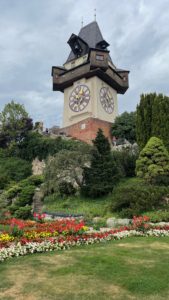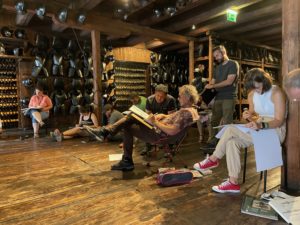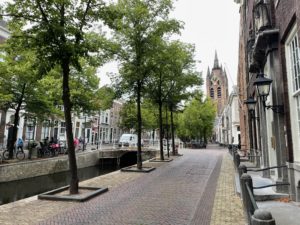
If you’re planning a trip to Europe next year or two, consider adding some lesser known destinations to your itinerary.
As I wrote in my recent column, “6 New Rules For Smarter European Travel,” increasing crowds and prices in Europe’s capitals mean that you could get a better experience in a country by visiting one of its smaller cities:
For example, France’s third-largest city, Lyon, has a lovely old town, spectacular Roman ruins, world-class museums and amazing restaurants. Even in peak season, I found a three-star hotel room for less than $100 a night and never encountered any long, soul-killing queues for attractions that could make Paris a trial.
Similarly, we enjoyed Austria’s second-largest city, Graz, a beautiful, affordable alternative to Vienna, and pretty Delft, a canal city just an hour’s train ride away from Amsterdam.
I would never recommend skipping Europe’s marvelous capital cities. But as tourism rebounds – as it did with a vengeance this summer – we’ve found the smaller cities help save our sanity as well as our wallets.
Let’s start with Graz, Austria. I’d never heard of it before my husband got an offer to teach drawing workshops there, but it’s Austria’s second-largest city (and Arnold Schwarzenegger was raised in nearby Thal). My husband loved Graz in part because it boasts the world’s largest historical armory. Shields, helmets, cannons and other weapons apparently are quite fun to draw.

A bit outside the city is an open air museum with homes and other buildings moved from all over southeast Austria. We’re huge fans of these museums, such as Skansen in Stockholm and the Ulster American Folk Park in Northern Ireland, because they provide an immersive experience of what life was like centuries ago in their countries. Plus, again, they’re fun to draw.
Like Vienna, Graz has plenty of baroque architecture as well as some Art Nouveau and ground-breaking modern architecture. (The modern art museum is nicknamed “The Friendly Alien” for its weird, bulbous shape.) There’s a magnificent cathedral, lively farmers’ markets and wonderful restaurants — I got hooked on the beef goulash at Glöckl Bräu, a casual eatery with tables beneath the dancing figures of the city’s 1905 glockenspiel. Graz also has an outpost of Cafe Sacher, the restaurant that invented the iconic Sacher torte. While the Vienna restaurant always had a huge line outside, I walked right into the Graz restaurant and had my torte within minutes. Another find was the rooftop restaurant at Kastner & Öhler (K&O) department store, which offered lovely views of the town and its hilltop fortress, including Graz’ iconic clock tower.
The tower is one of the few buildings that survives from a once-impressive fortress that was destroyed by Napoleon’s forces in the early 19th century. Now the area is a beautifully landscaped park with a few ruins, multiple entertainment venues and some restaurants, including the delicious aiola upstairs. You can access the fortress via a funicular railway, a long hiking trail or a steep set of stairs that will really give you a workout. Getting back down is much easier: there’s a corkscrewing slide, drilled right through the mountain, that you can ride for five euros (and yes, it’s a thrill).
Graz is about a two-hour train ride from Vienna, so it’s possible to stay there and take day trips into the larger city as well as into the neighboring countryside to visit wineries, castles and abbeys.
Lyon is, similarly, about two hours from Paris via high speed train. But in our many trips to Paris – including a month-long stay in 2014 – I’d somehow never made it there. Je regrette ça, as I think the French would say (mon français est awful). But while scrolling around during pandemic lockdowns, I’d discovered the website of a cinema arts museum in Lyon with a magnificent collection of miniature scenes, and was determined to get there.

My husband was teaching in Paris, so I booked a quick solo side trip.
Within an hour of arriving, I was checked in to a cozy three star hotel that cost about half what a similar accommodation would charge in Paris. The friendly woman who checked me in supplied me with a map, recommendations on what to do and a dinner reservation for a terrific bouchon, a traditional type of Lyon eatery, for dinner. She told me about the traboules, or hidden passages throughout the old town that reportedly were used by silk makers to avoid the rain, and urged me to visit the Roman amphitheaters (Lyon was the capital of Gaul back in the day). When she found out I was only staying a night, she shook her head regretfully and urged me to return for a longer stay with my husband. That experience was repeated several times – people would ask how long I was staying, and express dismay that my visit wasn’t longer. I can’t imagine a Parisian asking, or caring, how long a tourist was in their city!
Which brings me to the other advantage of visiting less-trampled cities: it’s just a warmer experience, with more opportunities to chat with locals and soak up the atmosphere.
The two other alternate cities I wanted to mention were in the Netherlands. Work took my husband to Rotterdam, and I took advantage of the time to explore that city and lovely Delft.

Rotterdam used to look a lot like Amsterdam, but 13 minutes of Nazi bombing and three days’ of resulting fires effectively flattened the city. Today it’s known as “Manhattan on the Maas River” for its business orientation and its spectacular modern architecture. There’s an art storage facility that looks like a massive mirrored planter; a giant arched market hall with shops on the ground and apartments in the walls; bright yellow “cube houses” perched on their ends; and a spectacular train station with a soaring modern roof, among other notable buildings. The Port of Rotterdam is Europe’s largest, and a fascinating maritime museum offered insights into its history as well as opportunities for kids to pilot little boats in a protected bay.
Rotterdam’s historic core wasn’t completely wiped out: In Oude Haven, you’ll find a small neighborhood of canals, historic buildings and a windmill that survived World War II. Not far away is a city museum with a small but immersive exhibit about life in Rotterdam during the occupation.

For more canals and quaint buildings, check out Delft, about 45 minutes from Rotterdam by train. Delft is popular with tourists but has a much saner vibe than anything-goes Amsterdam. It also has grand churches, a sprawling market square and – of course – shops loaded with the blue and white pottery for which it’s known.
And all these are just a fraction of the many, many alternate destinations there are to explore. Let me know if you find others. Happy travels!